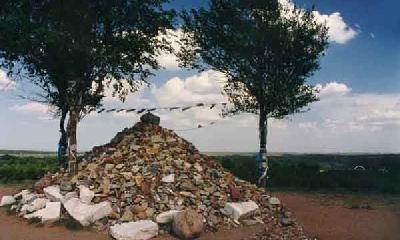| Curiosity > Custom |
|
|
Aobao Meeting
Aobao, which means pile or hill, is the traditional worship festival of the Evenki ethnic minority and takes place from April to June of each lunar year. The festival prevails in the Evenki inhabited area of Heilongjiang Province and the Inner Mongolia Autonomous Region. Aobao worship involves praying for good weather and safety for both humans and livestock. The Aobao is mainly located on top of mountains, piled like the shape of a taper with stones or clods and colorful cloth strips or paper hung on top.
According to legend, a woman who went to a village in a sedan chair drawn by a mule caused a storm and the whole village suffered from the disaster. That winter, when people broke the frozen ice in rivers to fetch water, they discovered a woman with disheveled hair. At that precise moment, winds began to howl and it suddenly started snowing. Everyone was petrified.
Rituals of the Aobao include clan worship, family worship, and village, banner and league worship. Different styles of the Aobao are worshipped in various scopes. For instance, the Aobao of the clan is held inside the family, and the offerings and costs are shared among them. The Aobao of the league is worshipped within the scope of the league and the offerings and other associated costs are shared by people in the league. There are also volunteers who often contribute. The well-off families can present several sheep at one time. A person is appointed as herdsman of the surplus livestock for next year's offerings.
During the festival, people from far and wide gather to the Aobao to take part in worship activities. After a horse race, the offerings are served and the lamas pray for worship. The participants start adding stones to the Aobao one after the other. When it is finished, entertainment, such as wrestling, singing and dancing, is provided.
Nowadays, the Aobao Meeting is considered more as mass entertainment rather than religious worship, featuring sports activities and commercial events that are similar to the Mongolian Nadam Fair. |
||||
All rights reserved. Reproduction of text for non-commercial purposes is permitted provided that both the source and author are acknowledged and a notifying email is sent to us. |
||||
 |
